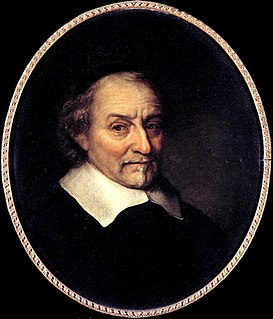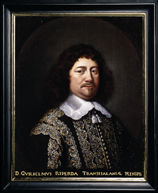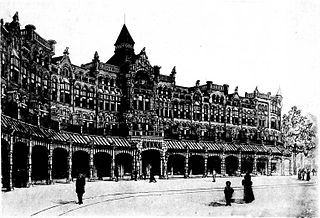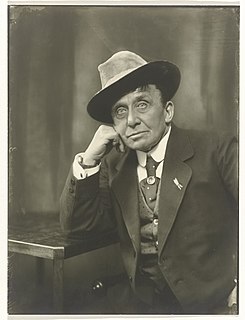
Joost van den Vondel was a Dutch poet, writer and playwright. He is considered the most prominent Dutch poet and playwright of the 17th century. His plays are the ones from that period that are still most frequently performed, and his epic Joannes de Boetgezant (1662), on the life of John the Baptist, has been called the greatest Dutch epic.

The Royal Palace of Amsterdam in Amsterdam is one of three palaces in the Netherlands which are at the disposal of the monarch by Act of Parliament. It is situated on the west side of Dam Square in the centre of Amsterdam, opposite the War Memorial and next to the Nieuwe Kerk.

Justus van Effen was a Dutch author, who wrote chiefly in French but also made crucial contributions to Dutch literature. A journalist, he imitated The Spectator with the publication of the Dutch-language Hollandsche Spectator. He gained international fame as a writer of French periodicals and a translator from English into French, and he is also recognized as one of the most important Dutch language writers of the 18th century and an influential figure of the Dutch Enlightenment.
Heineken Lager Beer, or simply Heineken is a pale lager beer with 5% alcohol by volume produced by the Dutch brewing company Heineken N.V.. Heineken beer is sold in a green bottle with a red star.
De Nieuwe Gids was a Dutch illustrated literary periodical which was published from 1885 to 1943. It played an important role in promoting the literary movement of the 1880s. Its contents covered a wide range of topics, extending to developments in science.

Christoph Wittich or Christophorus Wittichius was a German-born Dutch theologian. He is known for attempting to reconcile Descartes' philosophy with the Scriptures.

Samuel Iperuszoon, Knight Wiselius was a successful Dutch lawyer and a prominent Patriot and democrat, involved in the dismantling of the Dutch East India Company (VOC) and the negotiations over the Cape. Wiselius was a witty, Voltairian spirit with political views far ahead of his time who would end his days writing dramas on Classical themes. Wiselius corresponded with nearly all the main players at the time of the Batavian Republic and it would be impossible to know that period completely without his carefully kept and neatly written correspondence. He was also a poet, historian and superintendent of the police.
The history of Dutch nationality is the emergence of a sense of national identity in the territory of the Netherlands. Consciousness of national identity was manifested through shared national obligations and rights such as taxation, military service, political and social rights, but most importantly through the concept of citizenship. Dutch nationality was forged through conflict which helped the people of the Low Countries develop a unifying idea of the Netherlander.

Willem, Baron Ripperda, Lord of Hengelo, Boekelo, Boxbergen, Rijsenburg and Solmsburg, was an ambassador at the peace conferences of Osnabrück and Münster which ended both the Thirty Years' War in Germany and the Eighty Years' War between Spain and the Netherlands.
The Marnix, het Rotterdamse Gymnasium is a school located in Rotterdam, Netherlands. The school is named after Philips of Marnix, lord of Saint-Aldegonde. It teaches secondary education in the Netherlands and prepares students for a tertiary education at Dutch universities.

Raadhuisstraat is a street in Downtown Amsterdam, in the Netherlands. It is located between Nieuwezijds Voorburgwal and Prinsengracht. The street is named after the former City Hall or Town Hall, now the Royal Palace and it contains the gallery. It is the main thoroughfare into Old Centre.
Arie Theodorus van Deursen was a Dutch historian whose focus was the early modern period. He was Professor Emeritus of History at the Vrije Universiteit in Amsterdam. He was a specialist in Dutch history of the 16th and 17th century.
The Treaty of Elbing was signed between the Dutch Republic and the Swedish Empire on 1 September (OS) / 11 September 1656, during the Second Northern War, in Swedish-held Elbing (Elbląg). It served to protect Dutch interests in the Baltic Sea, ended the Dutch intervention in the Swedish siege of Danzig, and renewed a fragile peace between the Dutch Republic and Sweden. Within the former, there was opposition to the treaty demanding elucidations, which were agreed upon only on 29 November (OS) / 9 December 1659 in the Convention of Helsingör. Earlier in 1659, in the Concert of The Hague, England, France, and the Dutch Republic had agreed to include the treaty of Elbing in their common agenda regarding the Second Northern War.
The Concert of The Hague, signed on 21 May 1659, was an outline of the common stance of England, France and the Dutch Republic regarding the Second Northern War. The powers agreed that the Swedish Empire and Denmark–Norway should settle for a peace treaty based on the Treaty of Roskilde, including free navigation through The Sound and the Baltic Sea based on the Treaty of Elbing. The subsequent Dano-Swedish Peace of Copenhagen largely followed the terms dictated by the Concert of the Hague.

Elisabeth Samson (1715—1771) was an Afro-Surinamese coffee plantation owner. She was born in 1715 in Paramaribo to a freed slave, known as Mariana. All of her other siblings had been born as slaves and were emancipated by her half-brother Charlo Jansz. Raised in the home of her half-sister Maria Jansz, Samson was taught to read and write by her brothers-in law who also trained her in business. She began acquiring property at the age of 19, but was banished from the colony in 1736 after being convicted of slander. Her appeal, heard by the Dutch Parliament, was successful and she returned to Suriname in 1739.
Bartholomeus Ruloffs was a Dutch conductor and composer.
Jean-Baptiste de Bouge (1757–1833) was a Belgian cartographer whose career spanned decades of major political upheaval, his country in turn being the Austrian Netherlands, the United Belgian States, the French First Republic, the Napoleonic Empire, and the United Kingdom of the Netherlands, before becoming the Kingdom of Belgium. He often worked with the cartographic engraver Philippe Joseph Maillart.
Margaret Jacob is an American historian of science.

Louis Frederik Johannes Bouwmeester was a Dutch actor best known for his Shakespeare interpretations. He is also known as Louis Bouwmeester Sr. for distinction from his son.
Surinamese nationality law is regulated by the 1987 Constitution, the Allocation Agreement of 1975, and the 2014 Surinamese Nationality Law. It is highly influenced by Dutch law. These statutes determine who is, or is eligible to be, a citizen of Suriname. Surinamese citizenship is typically obtained either under the rules of jus sanguinis, i.e. birth to at least one parent with Surinamese nationality; or on the principle of jus soli, i.e. by birth in Suriname. It can also be granted to a permanent resident who has lived in Suriname for a given period of time or by presidential decree through naturalization.










